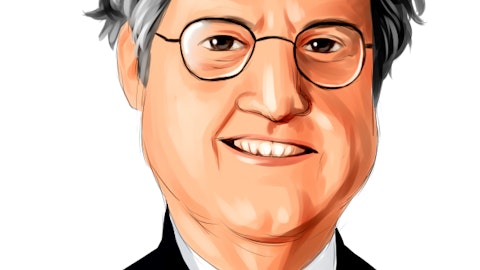OneMain Holdings, Inc. (NYSE:OMF) Q1 2023 Earnings Call Transcript April 25, 2023
OneMain Holdings, Inc. misses on earnings expectations. Reported EPS is $1.46 EPS, expectations were $1.65.
Operator: Welcome to the OneMain Financial First Quarter 2023 Earnings Conference Call and Webcast. Hosting the call today from OneMain is Peter Poillon, Head of Investor Relations. Today’s call is being recorded. At this time, all participants have been placed in a listen-only mode, and the floor will be open for your questions, following the presentation. . It is now my pleasure to turn the call over to Peter Poillon. Sir, you may begin.
Peter Poillon: Thank you. Good morning, everyone, and thank you for joining us. Let me begin by directing you to Page 2 of the first quarter 2023 investor presentation, which contains important disclosures concerning forward-looking statements and the use of non-GAAP measures. The presentation can be found in the Investor Relations section of our Web site. Our discussion today will contain certain forward-looking statements reflecting management’s current beliefs about the company’s future, financial performance and business prospects and these forward-looking statements are subject to inherent risks and uncertainties and speak only as of today. Factors that could cause actual results to differ materially from these forward-looking statements are set forth in our earnings press release.
We caution you not to place undue reliance on forward-looking statements. If you may be listening to this via replay at some point after today, we remind you that the remarks made herein are as of today, April 25 and have not been updated subsequent to this call. Our call this morning will include formal remarks from Doug Shulman, our Chairman and Chief Executive Officer; and Micah Conrad, our Chief Financial Officer. After the conclusion of our formal remarks, we will conduct a question-and-answer session. I would now like to turn the call over to Doug.
Doug Shulman: Thanks, Pete, and good morning, everyone. Thanks for joining us today. Today I will cover our results for the quarter, our positioning in this uncertain macroeconomic environment and our strategic initiatives. Let me start with some highlights of our performance in the first quarter. We produced net income of $179 million and $179 million of capital generation in the quarter. We continue to see strong demand for our loan products. In what is typically a seasonally lower quarter for our lending business, we had $2.8 billion of originations despite our continued tight credit box. It is a very constructive competitive environment for us, and our strong balance sheet allows us to continue to provide responsible access to credit for our customers and make every loan that meets our risk return criteria.
Our top two risk grades, those with the best credit quality and lowest risk customers, made up approximately 65% of new customer originations in the first quarter as compared to mid 2021 levels of 30% to 40%. We’re pleased with the opportunities we see to write higher credit quality loans at a pace that is modestly ahead of our expectations coming into the year. Turning to credit, our 30 to 89 delinquency rate finished the quarter at 2.58%, 49 basis points below where we ended last quarter and in line with seasonal trends. Our underwriting remains quite conservative. This credit posture, combined with favorable competitive dynamics at the higher end of our credit spectrum, is leading to an increase in the overall credit quality of our portfolio.
Loan net charge-offs in the quarter were 7.7%, in line with our expectations, aided by continued solid performance in late stage collections and post charge-off recoveries. The adjustments we made to our credit box in the middle of last year are driving improved early delinquency performance as we progress through the year. While still elevated, our back book of loans which were originated before our credit tightening last summer has stabilized, and the loans we have originated post tightening are performing in line with expectations. As post tightening vintages become a bigger portion of the portfolio, we should see credit move toward more normalized levels. Nonetheless, we continue to closely monitor the environment and our portfolio and remain poised to adjust as needed.
Let me now talk for a minute about the macroeconomic environment. We’re encouraged by the continued low unemployment numbers and what appears to be a reduction in the pace of inflation. Regardless, we continue to maintain a conservative credit posture as economic uncertainty persists. In light of recent developments in the banking sector, I want to stress that at OneMain we have built our strategy and balance sheet to be durable across a range of macroeconomic environments. This includes a diversified balance sheet with staggered maturities, a long liquidity runway, disciplined asset liability management, and conservative underwriting. It is precisely in volatile environments like the one we are in now that our strength is most evident, and positions us to be a reliable and trusted partner for our customers when they count on us most.
Turning to our BrightWay credit card, we are pleased with the continued progress. We are closely monitoring spend volume, balance builds, revolve rates and credit performance as we continue our rollout into very targeted segments of the nonprime market. Just like the posture we are taking with personal loans, we are maintaining a conservative credit box in our card product and are only taking on customers that we are confident will meet or exceed our return hurdles even if the economy were to worsen from here. At quarter end, we had more than 160,000 card customers and $122 million of card receivables. And we’re really pleased with the continued digital adoption as 99% of eligible customers who make six on-time payments make their choice to decrease their interest rate or increase their line in our app, and over 85% of customers are making payments in the app.
We remain confident that our approach to carefully scaling cards while maintaining conservative underwriting standards is the right approach to build a strong business for the future with excellent returns. We also continue to see strong origination volume and good credit performance in our secured lending distribution channels. Loans from these channels today total nearly 500 million of receivables. I’m also pleased with our continued pace of innovation, especially around digital tools for customers. For example, when delinquencies ticked up last year, we shifted more of our branch team members’ time to collection activities. As we have invested in digital capabilities over the past several years, we not only have the ability to shift human resources to the highest value work depending on the week, month or year, but have given our team members and our customers more digital tools to improve efficiency, outcomes, and customer experience.
Two great examples of this are click to pay links embedded in emails and enhanced two way texting. When we need to reach out to customers, we don’t just call them. We can text or email them. And when customers receive a text or email, they can then either engage with us via their channel of choice or complete a task like making a payment using a digital tool. These new digital capabilities are driving efficiency in our operations and a more seamless customer experience. Let me end by touching on capital return. Our $4 per share annual dividend translates into an approximately 10% yield at our current share price. During the first quarter, we repurchased about 700,000 shares for $27 million. As we discussed last quarter, we have moderated our share repurchases, given the uncertain economic environment and our desire to maintain strategic optionality.
That said, we remain a programmatic buyer of our shares, and we’ll adapt the pace of repurchases as the environment evolves. I’ll conclude here by reiterating that we feel very good about the strategic and competitive positioning of OneMain and the results for the quarter. With that, let me turn the call over to Micah.
Micah Conrad: Thanks, Doug. Good morning, everyone. We had a solid quarter, and we continue to see positive credit trends following our August 2022 tightening. Receivables have been supported by strong demand, and we raised another 750 million of funding in challenged markets. While the environment remains uncertain, we are well positioned for both the short and long term. Our first quarter net income was $179 million, or $1.48 per diluted share, down from $2.38 per diluted share in the first quarter of 2022. C&I adjusted net income was $177 million, or $1.46 per diluted share, down from $2.36 per diluted share in the prior year quarter, and capital generation was $179 million for the quarter compared to 282 million a year ago.
Keep in mind these prior year variances reflect difficult comparisons against the stimulus driven and historically low net charge-off levels we saw in the first quarter of 2022. We continue to see strong demand for our loan products supported by a constructive competitive environment and continued progress in new products and channels. As a result, originations were $2.8 billion in the first quarter despite our tighter underwriting posture. Pricing continues to be stable and remains above 2021 levels. We have increased pricing in certain segments to offset the impact of a higher credit quality mix of originations, which generally has lower pricing. Managed receivables were $20.6 billion, down slightly from the fourth quarter, which is typical in tax season.
However, receivables growth was strong versus last year at 1.1 billion, or 6%. We are now trending towards mid single digit growth in receivables for the full year. As a reminder, managed receivables includes 839 million of receivables sold through our forward flow agreements and 122 million of credit card balances. Let me now walk through the components of our first quarter C&I results. Interest income was $1.1 billion, flat to the prior year quarter. Yield was 22.3%, flat sequentially and down about 80 basis points year-over-year, reflecting higher 90 plus delinquency and the impacts of payment assistance we are providing to customers where needed. We continue to expect modest improvement in yield over the course of the year, driven by normal seasonal delinquency patterns, the impact of our credit tightening on portfolio delinquency, and the pricings actions we’ve taken over the past year.
Interest expense was $238 million, up 21 million, or 9% versus the prior year, primarily from an increase in average debt to support our receivables growth. Interest expense as a percentage of receivables was 4.8%, up modestly from 4.6% a year ago, despite what has been an historic increase in benchmark rates. Changes on our interest expense will generally be gradual, given our balanced debt mix and fixed rate long duration maturities. Other revenue was $176 million, up $18 million, or 11% from the prior year quarter. The increase was primarily attributable to higher yields on our investment portfolio and our cash balances. Provision expense was $385 million and included current period net charge-offs and a modest increase to our allowance.

Photo by DocuSign on Unsplash
Policyholder benefits and claims expense was $47 million compared to $42 million in the first quarter of 2022. Let’s turn to the C&I credit trends highlighted on Slide 7. 30 to 89 loan delinquency was 2.58% in the first quarter, down from 3.07% in December. This sequential reduction of 49 basis points is at the higher end of reductions we typically see in the first quarter. This is due in part to our post tightening originations growing as a share of our receivables. Post August 2022 vintages as of March 31 comprised 38% of total receivables compared to 27% at year end. On Slide 8, we show the delinquency performance of our September 2022 originations at six months on book and our fourth quarter ’22 originations at three months on book, both are performing very much in line with our expectations.
And while we are encouraged to see new originations performing well, our seasoned vintages continue to track above pre-pandemic levels, and we are proactively working with customers through what continues to be a challenging time. Loan net charge-offs were 376 million, or 7.7% for the quarter, consistent with our expectations. Net charge-offs were supported by strong recoveries of 1.4% of average receivables. Recoveries remain above pre-pandemic levels of approximately 0.8% driven by our strong operational performance as well as opportunistic sales of charged off inventory. This quarter’s recoveries include 11 million of proceeds from a sale. We are maintaining our full year net charge-off range of 7.0% to 7.5%. We expect net charge-offs to improve in the back half of the year, given normal seasonal trends and improving credit quality within the portfolio.
Turning to Slide 9, I wanted to quickly highlight an accounting standard update that impacted our CECL reserves in the quarter. The standard became effective on January 1 and eliminates the accounting guidance for troubled debt restructurings, including the specific reserving methodology for these loans. In accordance with the adoption of this new standard, our C&I allowance was reduced by approximately $20 million, with that adjustment flowing directly to retained earnings. The reduction was then partially offset by an increase of $3 million that ran through provision expense in the first quarter income statement for a net change of 17 million. The economic factors used in our CECL reserves were unchanged from the prior quarter. And as a result, our reserve ratio was consistent at 11.6%.
C&I operating expenses were 362 million in the quarter, down 5 million sequentially and up a modest 4% year-over-year. Our operating expense ratio was 7.1% in the quarter, which is in line with our full year guide. We remain focused on cost discipline and even more so given the current market uncertainty. We’re also focused on continuing to invest in growth initiatives for the future. The majority of our year-over-year expense growth came from investment in our new products and channels, with our core expense up just 2% versus the first quarter of 2022. Let’s now turn to Slide 11 for an update on our balance sheet and our funding. One of the key strengths of OneMain is our strong balance sheet, characterized by a balance of funding sources, long duration staggered maturities and a strong liquidity profile.
Our secured funding mix is currently 55% of our outstanding debt. The duration of our debt is just over three years. And our next significant unsecured maturity is not until 2024 having just paid off an $800 million maturity last month. The proactive management of our funding structure and our balance sheet has significantly reduced the impact of rising rates on our interest expense, and has given us a great degree of issuance flexibility over the past year. In February, we completed a three-year revolving $750 million Auto ABS issuance with an average coupon of 5.6%. This was below the 6.0% coupon from our December issuance, even with an increase in advance rate from 73% to 95%. We saw strong support from both returning and new investors, and the issuance was well oversubscribed demonstrating the confidence investors have in OneMain.
Our liquidity is supported by 7.4 billion of committed bank facilities spread across 15 geographically diverse and well established financial institutions. These are typically three-year commitments with staggered terms. And since the beginning of 2022, we renewed 9 of these 15 relationships, securing continued liquidity well into 2025 and 2026. And our capital adequacy remains strong, with net leverage of 5.4x, down from 5.5x last quarter. With that, I’d like to turn the call back to Doug.
Doug Shulman: Thanks, Micah. OneMain remains in a very strong competitive position, as we continue to provide access to credit for our customers and to help them through this uncertain time. Our balance sheet is strong, enabling us to make every loan that meets our risk return thresholds. Our back book remains stable, and the loans we have originated post tightening are performing in line with expectations. We continue to invest in new products and our omni-channel platform, allowing us to better serve more customers over time. As we close, let me thank all of our talented and dedicated team members across the country who help our customers improve their financial well being every day. With that, we’ll open it up for questions.
See also 11 Best Waste Management Stocks to Buy Now and 35 Most Beautiful Places In The World.
Q&A Session
Follow Onemain Holdings Inc. (NYSE:OMF)
Follow Onemain Holdings Inc. (NYSE:OMF)
Operator: Thank you. The floor is now open for questions. . And our first question will come from John Hecht with Jefferies. Your line is open.
John Hecht: Hi, guys. Good morning. Thanks very much for taking my question. First question is you sometimes have a detailed slide within the deck pertaining to guidance. I think you guys touched on various components of the guidance in your prepared remarks. But I’m wondering as you think about the details you provided with respect to guidance in the past, is there anything — changes or anything that’s trending a little better, a little worse than expected or any update you can give on that regard?
Micah Conrad: Good morning, John. It’s Micah. Thanks for the question. We didn’t have any material updates as you heard from the prepared remarks to any of the strategic priorities. We’ve kind of given a lot of direction in the past also as we get into these question-and-answer sessions. I’m happy to review what we said just to make sure everyone’s clear and provide a little bit of textual commentary around the trends as well. On receivables growth, you’ve heard us say we’re trending towards mid single digits. As of today, we’re seeing strong demand for applications. We see a very strong and accretive competitive environment. And some of the payment dynamics in the portfolio are also supporting that mid single digit call out.
On yield, we put out 22.3 for the first quarter. That was, as you might remember, spot on to what I had guided to in the fourth quarter just in terms of where we thought we would be in the first. We do feel like we’re hitting a bottom on yield. We expect yield to modestly improve as we go through the year here with seasonal impacts and trends of 90 plus. Our credit box adjustments and the post August originations becoming a bigger part of our portfolio as the year goes on, and also some of the pricing increases that we’ve been making over the last year that we expect to start taking hold. So we do expect that modestly throughout the year to improve. Losses, we’re still trending in the 7% to 7.5% range that we had put out last quarter. I think last quarter, we also talked about the kind of trajectory of first half, second half.
We’re still in that ballpark. We think first half is going to be mid to high 7s, with mid to high 6s in the second half. And I think our delinquency results that you saw today support those expectations. And then interest expense and the OpEx ratio, we expect that to be relatively flat for the remainder of the year. So hopefully that’s helpful. It gives you enough to kind of get a sense for where we’re headed.
John Hecht: Yes. That’s very helpful. Thanks very much. And then second question just in thinking about the market, most lenders have announced some type of pullback in terms of tightening of underwriting. And these periods historically, that kind of presented an advantage for someone like OneMain in the sense that you could be more selective yet see a higher quality customer, new customer. And I’m wondering, Doug, some of your — the flavor of your remarks suggested you’re maybe seeing that, but maybe can you talk about customer acquisition costs and your ability to attract a higher quality customer in this type of environment?
Doug Shulman: Yes. John, as I said, we feel really well positioned in this market. We built our balance sheet with a lot of liquidity so that we didn’t have any — we weren’t forced to do any pull backs because of funding and we have plenty of funding. That allows us to stay in the market and serve our customers. With that said, we significantly tightened our credit box last summer. And post August, we cut out a lot of the lower performing credit. The business we’re booking today will be profitable and meet our return hurdles, even if the economy deteriorates. And I mentioned, we’ve got just around 65% of our business is being booked in higher credit quality customers, that’s generally goes above 660. In 2021, that was 30% to 40%.
And we’re doing it without increasing cost of acquisition. I think we’re just getting more of the market now. We’re getting it, a, because we have a balance sheet that can book loans that meet our return hurdles, b, because we still are in the marketing. And c, we’ve done a lot around just our product, our customer experience, our value proposition that we think, even in a more benign macro environment, we think we’d still be getting our fair share of the market. And we’ll just keep trying to have a great product, provides value to customers and work with our customers over time. And we feel pretty good that we’ll be able to grow the book. And as Micah said, we’re trending a little higher in originations than we thought we would at the beginning of the year, and we don’t see any reason for that to stop.
John Hecht: Perfect. Thanks very much, guys.





